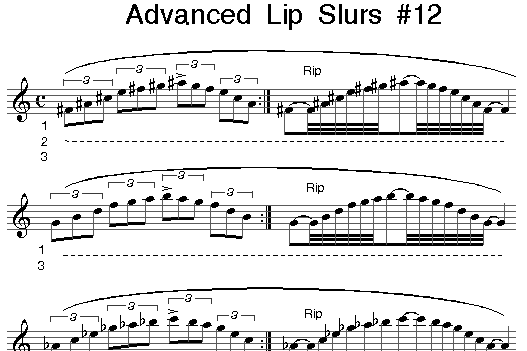





The Exercises chapter in the book is
84 pages in length (52 pages text
and pictures, 32 pages exercises).
However, relax, everything is easy to
understand. Here is a sampling...
The lip range of motion in an average embouchure is extremely
limited. Lip muscles are weak, barely capable of movement during the
highly pressurized conditions present within a trumpet embouchure
environment. Most students learn to play without any real idea of what
they're doing, automatically grabbing onto whatever security is
available. Their lips fall into a position that is limited, but it nevertheless
offers a sense of security, and they are encouraged to stay locked in
that setting. Sooner or later, the student reaches a plateau and
progress grinds to a halt.
What's needed is to move beyond the temporary (dead-end) security offered by an inefficient position and instead continue to extend the lip range of motion more or less in the right direction. I found that when you extend the range of motion of the lips by using specially designed exercises done outside of the normal playing range, the lips begin to spontaneously use elements of those movements during regular playing and reach a point of balance. In other words, the lips tend to correct themselves, forming into a more complex and beneficial shape than any teacher could intellectually conceive.
If you don't understand the basic mechanics of embouchure, you can still reach a balance point, but it will be by sheer luck. The path to success is well hidden and can be easily missed. For example, in the early stages of development in the Balanced Embouchure, it's not apparent that you are doing anything intelligent. Most students are initially surprised that exercises that sound and feel so odd are capable of generating such incredible results.
So I invite you to begin this process and find out the truth for yourself. Some of you are relatively new to the trumpet and will have no reservations about starting these exercises right away. For others...
Fear of Change
The biggest obstacle to activating more pieces of the puzzle (increasing your range of motion) is fear - fear of disrupting or losing the current fragile chop setting (that's been worked on for years) and ending up worse than before.
Much of this fear comes from a constant struggle to get the lips to move in an embouchure that is conditional - in other words, an embouchure that depends upon conditions being perfect for it to work properly. A conditional embouchure always has a limited range of motion. It's characterized by lots of nervous fiddling with lip position, a constant need to warm up again and again, and the nagging concern over whether or not this will be a "good" day.
With players feeling so much fear, the idea of improving by changing lip position is normally met with much resistance. That's one reason these exercises are so valuable. They are designed to let players continue their current performance level while gradually activating the new lip muscles. Some players maintain two separate embouchures, one for rehearsal/performance, and one for practice, while building up their strength. When the lips begin to move, the fear diminishes. Confidence increases as they spontaneously begin to experience an expanded range of lip movement and shift into a more secure feeling of gripping the mouthpiece. Slowly and naturally, the old chops fade away.
Roll In/Roll Out Summary
The Roll-Out and Roll-In exercises, easy enough for a sixth grader to learn (and many have) are the heart of the system. Looking at the diagram below, there is a middle section which represents the limited, habitual range of lip movement most players have. On the left is Roll-Out, an extended range of motion achieved by rolling out the lips (puckered) and playing double pedal tones (two octaves below the regular playing range) in a very specific, focused way. On the right is the opposite movement, a lips rolled inwards (facial muscles bunching towards the mouthpiece) "squeak" resulting in pitches above the staff. In both movements, the lips are closed prior to playing, allowing the air pressure to create an opening for the buzz.
What's needed is to move beyond the temporary (dead-end) security offered by an inefficient position and instead continue to extend the lip range of motion more or less in the right direction. I found that when you extend the range of motion of the lips by using specially designed exercises done outside of the normal playing range, the lips begin to spontaneously use elements of those movements during regular playing and reach a point of balance. In other words, the lips tend to correct themselves, forming into a more complex and beneficial shape than any teacher could intellectually conceive.
If you don't understand the basic mechanics of embouchure, you can still reach a balance point, but it will be by sheer luck. The path to success is well hidden and can be easily missed. For example, in the early stages of development in the Balanced Embouchure, it's not apparent that you are doing anything intelligent. Most students are initially surprised that exercises that sound and feel so odd are capable of generating such incredible results.
So I invite you to begin this process and find out the truth for yourself. Some of you are relatively new to the trumpet and will have no reservations about starting these exercises right away. For others...
Fear of Change
The biggest obstacle to activating more pieces of the puzzle (increasing your range of motion) is fear - fear of disrupting or losing the current fragile chop setting (that's been worked on for years) and ending up worse than before.
Much of this fear comes from a constant struggle to get the lips to move in an embouchure that is conditional - in other words, an embouchure that depends upon conditions being perfect for it to work properly. A conditional embouchure always has a limited range of motion. It's characterized by lots of nervous fiddling with lip position, a constant need to warm up again and again, and the nagging concern over whether or not this will be a "good" day.
With players feeling so much fear, the idea of improving by changing lip position is normally met with much resistance. That's one reason these exercises are so valuable. They are designed to let players continue their current performance level while gradually activating the new lip muscles. Some players maintain two separate embouchures, one for rehearsal/performance, and one for practice, while building up their strength. When the lips begin to move, the fear diminishes. Confidence increases as they spontaneously begin to experience an expanded range of lip movement and shift into a more secure feeling of gripping the mouthpiece. Slowly and naturally, the old chops fade away.
Roll In/Roll Out Summary
The Roll-Out and Roll-In exercises, easy enough for a sixth grader to learn (and many have) are the heart of the system. Looking at the diagram below, there is a middle section which represents the limited, habitual range of lip movement most players have. On the left is Roll-Out, an extended range of motion achieved by rolling out the lips (puckered) and playing double pedal tones (two octaves below the regular playing range) in a very specific, focused way. On the right is the opposite movement, a lips rolled inwards (facial muscles bunching towards the mouthpiece) "squeak" resulting in pitches above the staff. In both movements, the lips are closed prior to playing, allowing the air pressure to create an opening for the buzz.
There are three stages of development:
1. Each exercise (Roll-In and Roll-Out) is learned independently. The player must experience the exact sound and feel associated with each. Together, they provide stable reference points from which the full range of motion emerges.
2. The lip feeling developed in each exercise is then dragged into the normal playing range. For example, the Roll-Out exercise starts with a double pedal tone and climbs upwards, all the while attempting to maintain the original exaggerated feel of the pedal. Roll-Out drags notes upwards. Roll-In drags notes downwards.
3. After the new, complex lip motion begins to take hold in the normal playing range, the embouchure can now begin to execute a continuous flex, from rolled out pedal tones, ascending upwards, to rolled in upper register notes. Specially designed lip slurs are then performed to help smooth over gaps in the continuous flex, and minimize excess lip movement.
At this point, the embouchure has integrated the combined elements of rolled in and rolled out motion in a way that is unique to the student's lip architecture, creating a relatively balanced state. There is no 100% perfect model for how this should look, but there are general tendencies which are illustrated (in the book) in detail.
Like any high-level physical activity, an efficient embouchure requires extraordinary coordination. There are many pieces to the puzzle that must fall into place for it to work properly. These pieces are organized by your unconscious mind. By focusing on moving your lips more or less in the right direction, you are giving your unconscious mind the tools needed to form the balance point.
1. Each exercise (Roll-In and Roll-Out) is learned independently. The player must experience the exact sound and feel associated with each. Together, they provide stable reference points from which the full range of motion emerges.
2. The lip feeling developed in each exercise is then dragged into the normal playing range. For example, the Roll-Out exercise starts with a double pedal tone and climbs upwards, all the while attempting to maintain the original exaggerated feel of the pedal. Roll-Out drags notes upwards. Roll-In drags notes downwards.
3. After the new, complex lip motion begins to take hold in the normal playing range, the embouchure can now begin to execute a continuous flex, from rolled out pedal tones, ascending upwards, to rolled in upper register notes. Specially designed lip slurs are then performed to help smooth over gaps in the continuous flex, and minimize excess lip movement.
At this point, the embouchure has integrated the combined elements of rolled in and rolled out motion in a way that is unique to the student's lip architecture, creating a relatively balanced state. There is no 100% perfect model for how this should look, but there are general tendencies which are illustrated (in the book) in detail.
Like any high-level physical activity, an efficient embouchure requires extraordinary coordination. There are many pieces to the puzzle that must fall into place for it to work properly. These pieces are organized by your unconscious mind. By focusing on moving your lips more or less in the right direction, you are giving your unconscious mind the tools needed to form the balance point.
A Sample Exercise from the Lip Slur Section
